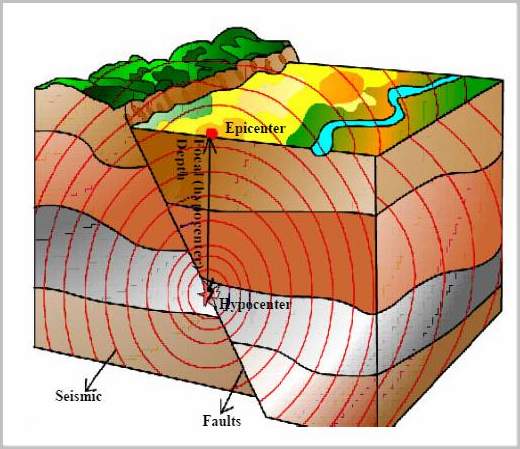Earthquakes are produced when a sudden slip occurs between two plates on the earth´s surface. An earthquake creates the movement of the ground in the earth´s surface, and the shaking created causes accumulated stress to be radiated out as seismic waves. Not all ground movements produced during an earthquake are easily noticed by people; however, very precise instruments can detect seismic waves. During an earthquake, seismic waves are originated at a point known as the hypocenter, and the vertical point above in the surface of the earth, from the hypocenter, is called the epicenter.
Plate tectonics
Most earthquakes occur at the region of plate boundaries. At this region, plates may pull apart, collide with each other, or slip sideways past each other. The earth´s crust comprises eight major plates and several minor plates. Over many years, stress may build up between two plates. After stress has accumulated sufficiently, a sudden slip occurs among the plates, and the built up energy is released as an earthquake. The Pacific Plate, which lies along the coastal regions of the Pacific Ocean, is one of the most active seismic regions in the world.

Hypocenter
The hypocenter of an earthquake is the location where the fault rupture starts, and is usually located at some depth under the surface of the ground. At the time of an earthquake, the hypocenter radiates seismic waves out in all directions. The expanding seismic waves travel at the speed of several kilometers per second and are what allow scientists to determine the location of the hypocenter. The variations of the speed due to the materials that the waves are encountering, before reaching each monitoring station, is taken into account in order to give an initial estimate of the location of the hypocenter.
Epicenter
The epicenter of an earthquake is located on the Earth´s surface directly above the earthquake´s point of origin or hypocenter. Seismologists usually name large earthquakes after the geographical regions, such as towns, cities or rivers which are near the epicenter of the earthquake. Seismologists normally use up to three measuring stations to find the epicenter. Both the hypocenter and epicenter are useful for visualizing an earthquake more easily; however, the hypocenter allows scientists to study the earth´s rupture with more detail.
After an earthquake occurs, there are subsequent small earthquakes known as aftershocks of all magnitudes which may last for months. These aftershocks signify that the earth´s surface is settling down into new positions, and they may last for as long as the seismic energy is released. The calculation of foreshocks, main shock and aftershock of an earthquake permits the three dimensional mapping of the rupture in the fault and the direction of the released energy. The use of linear equations helps calculate the difference between the observed arrival times of the shockwaves and those calculated at the location of the hypocenter.
While some earthquakes are weak, and thus, rarely noticed by people, others may grow larger and last longer. The factors that intervene in the fault´s rupture are complex, and are currently being researched. Seismologists make use of regions of high seismic activity, such as Southern California, where earthquakes are very common. The seismic monitoring instruments used for the surveillance of earthquakes comprises one of the largest in the world. This network of monitoring equipment may allow seismologists to obtain deeper knowledge regarding earthquakes.
Earthquakes have produced great destruction throughout earth´s history. The most devastating earthquake known to have occurred is one that hit China in 1557, where almost one million people were killed. The strongest recorded earthquake that has occurred recently is the one in Chile on May 22, 1960. According to earthquakecountry.info, there are seven steps that people should undertake in order to be prepared for an earthquake.

